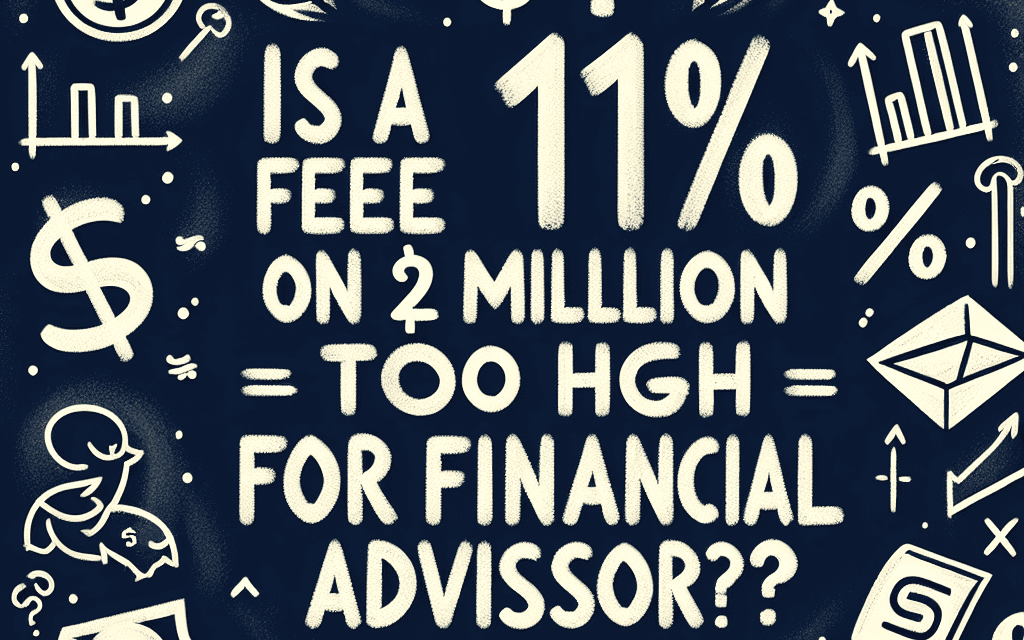“Maximize Your Wealth: Evaluate the Value of a 1% Advisory Fee on $2 Million.”
Introduction
When considering the management of a substantial investment portfolio, such as $2 million, the fees charged by financial advisors become a critical factor in determining the overall value and effectiveness of the advisory services. A common fee structure in the financial advisory industry is the assets under management (AUM) model, where advisors charge a percentage of the total assets they manage on behalf of their clients. In this context, a 1% fee on a $2 million portfolio translates to an annual cost of $20,000. Evaluating whether this fee is too high involves assessing the services provided, the advisor’s expertise, the potential for returns above market averages, and how these elements align with the investor’s financial goals and expectations. Understanding the implications of this fee structure is essential for investors to ensure they are receiving adequate value for the cost incurred.
Understanding Financial Advisor Fees: Is 1% Standard or Excessive?
When considering the services of a financial advisor, one of the most critical aspects to evaluate is the fee structure. A common question that arises is whether a 1% fee on a $2 million portfolio is excessive or standard. To address this, it is essential to understand the context and nuances of financial advisor fees, as well as the value these professionals provide.
Financial advisors typically charge fees based on the assets under management (AUM), and a 1% fee is often considered standard within the industry. This percentage is designed to align the advisor’s interests with those of the client, as both parties benefit from the growth of the portfolio. However, whether this fee is appropriate depends on several factors, including the services offered, the complexity of the client’s financial situation, and the advisor’s expertise.
To begin with, it is crucial to consider the range of services provided by the financial advisor. A comprehensive financial advisor does more than just manage investments; they offer holistic financial planning, which may include retirement planning, tax optimization, estate planning, and risk management. If the advisor provides a wide array of services that contribute to the client’s overall financial well-being, a 1% fee may be justified. Conversely, if the advisor’s role is limited to basic investment management, clients might question whether the fee is commensurate with the services rendered.
Moreover, the complexity of the client’s financial situation plays a significant role in determining the appropriateness of the fee. Clients with intricate financial circumstances, such as multiple income streams, diverse investment portfolios, or complex tax situations, may require more intensive management and personalized strategies. In such cases, a 1% fee could be seen as reasonable compensation for the advisor’s expertise and the tailored solutions they provide. On the other hand, clients with straightforward financial needs might find a 1% fee to be on the higher side, especially if their requirements do not demand extensive advisory services.
Another aspect to consider is the advisor’s experience and track record. An advisor with a proven history of delivering strong returns and providing valuable insights may justify a higher fee due to their ability to enhance the client’s financial outcomes. Additionally, advisors who hold advanced certifications or have specialized knowledge in certain areas of finance may offer a level of expertise that warrants the 1% fee. Clients should assess whether the advisor’s qualifications and past performance align with their financial goals and justify the cost.
Furthermore, it is important to compare the fee structure with industry standards and alternative options. While a 1% fee is common, some advisors may offer lower fees, particularly those who operate on a robo-advisory model or provide limited services. Clients should weigh the benefits of personalized advice against the cost savings of lower-fee options. Additionally, negotiating the fee or exploring performance-based fee structures could be viable strategies for clients who feel that the standard fee does not align with their expectations.
In conclusion, determining whether a 1% fee on a $2 million portfolio is excessive requires a thorough evaluation of the services provided, the complexity of the client’s financial situation, and the advisor’s expertise. By considering these factors and comparing them with industry standards, clients can make an informed decision about the value they receive relative to the cost. Ultimately, the appropriateness of the fee hinges on the alignment of the advisor’s offerings with the client’s financial objectives and needs.
Evaluating the Value: What Does a 1% Fee on $2 Million Get You?
When considering the financial management of a substantial portfolio, such as one valued at $2 million, the question of advisory fees becomes a significant point of deliberation. A common fee structure in the financial advisory industry is the 1% annual fee, which, in this case, would amount to $20,000 per year. At first glance, this may seem like a considerable sum, prompting investors to question whether the services provided justify the cost. To evaluate the value of a 1% fee, it is essential to understand what this fee typically encompasses and how it aligns with your financial goals.
Firstly, a 1% fee often includes comprehensive financial planning services. This means that your financial advisor is not merely managing your investments but is also providing a holistic approach to your financial well-being. This can include retirement planning, tax optimization strategies, estate planning, and risk management. By integrating these elements, an advisor can help ensure that your financial plan is cohesive and aligned with your long-term objectives. The expertise required to navigate these complex areas can be invaluable, particularly for individuals with significant assets.
Moreover, a financial advisor charging a 1% fee is likely to offer personalized investment management. This involves crafting a tailored investment strategy that considers your risk tolerance, time horizon, and financial goals. The advisor will continuously monitor your portfolio, making adjustments as necessary to respond to market conditions or changes in your personal circumstances. This active management can potentially enhance returns and mitigate risks, which is particularly important in volatile markets. The peace of mind that comes from knowing a professional is diligently overseeing your investments can be worth the cost for many investors.
In addition to investment management, a 1% fee often grants access to a wealth of resources and tools that individual investors might not have on their own. Financial advisors typically have access to advanced analytical tools, research, and insights that can inform better investment decisions. They may also have connections to a network of other professionals, such as tax advisors and estate attorneys, which can be leveraged to provide comprehensive advice. This network can be particularly beneficial when dealing with complex financial situations that require specialized knowledge.
Furthermore, the value of a financial advisor extends beyond tangible services. The behavioral coaching aspect of financial advising is often overlooked but can be crucial in helping investors avoid common pitfalls. Advisors can provide an objective perspective, helping clients stay disciplined and avoid emotional decision-making, which can be detrimental to long-term financial success. This guidance can be especially valuable during periods of market turbulence when investors might be tempted to make impulsive decisions.
While the 1% fee on a $2 million portfolio may initially appear steep, it is important to weigh this cost against the potential benefits. The expertise, personalized service, and peace of mind that a skilled financial advisor can provide may justify the expense for many investors. Ultimately, the decision should be based on whether the advisor’s services align with your financial needs and goals. By carefully evaluating the value provided, you can make an informed decision about whether a 1% fee is appropriate for your financial situation.
Comparing Fee Structures: Flat Fees vs. Percentage-Based Fees
When considering the cost of financial advisory services, the fee structure is a critical factor that can significantly impact your investment returns over time. One common model is the percentage-based fee, where advisors charge a percentage of the assets under management (AUM). For instance, a 1% fee on a $2 million portfolio equates to $20,000 annually. While this may seem substantial, it is essential to weigh this against the value of the services provided and compare it with alternative fee structures, such as flat fees.
Percentage-based fees are prevalent in the financial advisory industry due to their alignment with the advisor’s incentives. As the client’s portfolio grows, so does the advisor’s compensation, theoretically motivating the advisor to prioritize the client’s financial success. However, this model can become costly as the portfolio size increases, leading some investors to question whether the fee is justified, especially when the portfolio reaches substantial amounts like $2 million.
In contrast, flat fees offer a different approach. These fees are typically fixed and do not fluctuate with the size of the portfolio. This structure can be appealing to investors with larger portfolios, as it provides predictability and can potentially result in cost savings compared to percentage-based fees. For example, if a financial advisor charges a flat fee of $15,000 annually, this would be less than the $20,000 charged under a 1% AUM fee for a $2 million portfolio. However, it is crucial to consider whether the flat fee covers the same breadth and depth of services as the percentage-based fee.
Moreover, the choice between these fee structures should also take into account the complexity of the services required. Investors with straightforward financial needs might find that a flat fee suffices, while those with more complex financial situations, such as estate planning or tax optimization, might benefit from the comprehensive services often associated with percentage-based fees. Additionally, some advisors offer hybrid models, combining elements of both structures, which can provide a balanced approach tailored to the client’s specific needs.
Another consideration is the potential for conflicts of interest. With percentage-based fees, there is a risk that advisors might focus on growing the portfolio at all costs, possibly taking on more risk than the client is comfortable with. Conversely, flat fees might lead to a more transactional relationship, where the advisor is less incentivized to actively manage the portfolio once the fee is paid. Therefore, it is vital to assess the advisor’s commitment to fiduciary responsibility, ensuring that they act in the client’s best interest regardless of the fee structure.
Ultimately, the decision between flat fees and percentage-based fees should be guided by a thorough evaluation of the services offered, the advisor’s expertise, and the investor’s financial goals. It is advisable to have open discussions with potential advisors about their fee structures and how they align with your expectations and financial objectives. By doing so, investors can make informed decisions that not only consider the cost but also the value and quality of the advisory services received. In conclusion, while a 1% fee on a $2 million portfolio may initially appear high, it is essential to consider the broader context and the potential benefits that a skilled financial advisor can bring to your financial journey.
The Impact of a 1% Fee on Long-Term Investment Growth

When considering the services of a financial advisor, one of the most critical aspects to evaluate is the fee structure. A common model is the 1% fee on assets under management (AUM), which, at first glance, may seem negligible. However, when applied to a substantial portfolio, such as $2 million, the implications of this fee on long-term investment growth warrant careful consideration. To understand the impact of a 1% fee, it is essential to examine how it affects the compounding potential of investments over time.
Initially, a 1% fee on a $2 million portfolio amounts to $20,000 annually. While this figure might appear reasonable in exchange for professional financial management, it is crucial to recognize that this fee is deducted regardless of the portfolio’s performance. Consequently, the fee can significantly erode the compounding effect, which is a fundamental driver of wealth accumulation. Over time, the compounding effect allows investments to grow exponentially, as returns generate additional returns. However, when a portion of the portfolio is consistently withdrawn to cover fees, the base amount available for compounding diminishes, potentially leading to a substantial reduction in overall growth.
To illustrate, consider a scenario where a $2 million portfolio grows at an average annual rate of 7% before fees. Without any fees, the portfolio would grow to approximately $3.87 million over ten years. However, with a 1% annual fee, the effective growth rate drops to 6%, resulting in a portfolio value of about $3.58 million after the same period. This difference of nearly $290,000 underscores the significant impact that a seemingly modest fee can have on long-term growth.
Moreover, the effect of a 1% fee becomes even more pronounced over longer investment horizons. For instance, over 20 years, the difference in portfolio value between a 7% growth rate with no fees and a 6% growth rate with a 1% fee can exceed $1 million. This substantial disparity highlights the importance of carefully evaluating the cost of financial advisory services in relation to their potential benefits.
While the numerical impact of a 1% fee is clear, it is also important to consider the qualitative aspects of financial advisory services. A skilled advisor can provide valuable insights, strategic planning, and emotional support, which can be particularly beneficial during volatile market conditions. The expertise and guidance offered by a financial advisor can help investors avoid costly mistakes, optimize their portfolios, and achieve their financial goals more effectively. Therefore, the decision to engage a financial advisor should not be based solely on the cost but also on the value they bring to the table.
In conclusion, while a 1% fee on a $2 million portfolio may seem high when considering its impact on long-term investment growth, it is essential to weigh this cost against the potential benefits of professional financial management. Investors should carefully assess their individual needs, the advisor’s expertise, and the overall value proposition before making a decision. By doing so, they can ensure that their financial strategy aligns with their long-term objectives, ultimately maximizing their investment potential.
Negotiating Financial Advisor Fees: Tips for Reducing Costs
When considering the services of a financial advisor, one of the most pressing concerns for many investors is the cost associated with these services. Specifically, the question of whether a 1% fee on a $2 million portfolio is too high often arises. To address this, it is essential to understand the value that a financial advisor brings to the table and explore strategies for negotiating fees to ensure they align with the services provided.
A 1% fee on a $2 million portfolio translates to $20,000 annually. While this may seem substantial, it is crucial to evaluate the comprehensive services offered by the advisor. Financial advisors provide a range of services, including investment management, retirement planning, tax strategies, and estate planning. The expertise and personalized guidance they offer can be invaluable, particularly for those with complex financial situations. However, it is equally important to assess whether the services provided justify the cost.
To determine if the fee is reasonable, investors should first compare it with industry standards. Typically, financial advisor fees range from 0.5% to 2% of assets under management, depending on the level of service and expertise. A 1% fee falls within this range, but it is still worth considering whether the advisor’s performance and service offerings warrant this cost. Investors should evaluate the advisor’s track record, client testimonials, and any additional services that may be included in the fee.
Once an investor has a clear understanding of the value provided, the next step is to explore ways to negotiate fees. One effective strategy is to discuss the possibility of a tiered fee structure. This approach involves reducing the percentage fee as the portfolio size increases, which can be particularly beneficial for high-net-worth individuals. For instance, an advisor might agree to charge 1% on the first $1 million and 0.75% on the remaining $1 million, thereby reducing the overall cost.
Another option is to consider a flat fee arrangement. Some advisors are willing to work for a fixed annual fee rather than a percentage of assets under management. This can be advantageous for investors with larger portfolios, as it decouples the fee from the portfolio size and focuses on the services provided. However, it is important to ensure that the flat fee is competitive and reflects the advisor’s expertise and the complexity of the investor’s financial situation.
Additionally, investors should not hesitate to ask for a breakdown of the services included in the fee. Understanding what is covered can help identify areas where costs might be reduced. For example, if the investor does not require certain services, such as estate planning or tax preparation, they might negotiate a lower fee that excludes these components.
In conclusion, while a 1% fee on a $2 million portfolio may initially seem high, it is essential to weigh this cost against the value and services provided by the financial advisor. By comparing industry standards, considering alternative fee structures, and negotiating based on specific needs, investors can ensure they are receiving fair value for their investment. Ultimately, the goal is to establish a fee arrangement that aligns with the investor’s financial objectives while maintaining a productive and beneficial relationship with their advisor.
Alternatives to Traditional Financial Advisors: Exploring Robo-Advisors
In recent years, the financial advisory landscape has undergone significant transformation, driven by technological advancements and changing consumer preferences. As investors increasingly question the value of traditional financial advisors, particularly when faced with a 1% fee on substantial portfolios such as $2 million, the emergence of robo-advisors presents a compelling alternative. These digital platforms offer automated, algorithm-driven financial planning services, often at a fraction of the cost of their human counterparts. Consequently, understanding the potential benefits and limitations of robo-advisors is crucial for investors seeking cost-effective solutions.
To begin with, robo-advisors provide a streamlined and efficient approach to investment management. By leveraging sophisticated algorithms, these platforms can create and manage diversified portfolios tailored to an individual’s risk tolerance and financial goals. This automation not only reduces the need for human intervention but also minimizes the potential for human error, ensuring a consistent and objective investment strategy. Moreover, the lower operational costs associated with robo-advisors enable them to offer services at significantly reduced fees, often ranging from 0.25% to 0.50% of assets under management. For an investor with a $2 million portfolio, this translates to substantial savings compared to the traditional 1% fee, which amounts to $20,000 annually.
Furthermore, the accessibility and convenience of robo-advisors cannot be overstated. With user-friendly interfaces and 24/7 availability, these platforms empower investors to monitor and adjust their portfolios at their convenience. This level of accessibility is particularly appealing to tech-savvy individuals who prefer managing their finances through digital channels. Additionally, many robo-advisors offer features such as tax-loss harvesting and automatic rebalancing, which can enhance after-tax returns and maintain the desired asset allocation without requiring constant oversight.
However, while the cost-effectiveness and convenience of robo-advisors are undeniable, it is essential to consider their limitations. One significant drawback is the lack of personalized financial advice. Unlike traditional advisors who can provide tailored guidance based on a comprehensive understanding of an individual’s financial situation, robo-advisors rely on standardized algorithms that may not account for unique circumstances. This limitation can be particularly concerning for investors with complex financial needs, such as estate planning or tax optimization, where personalized advice is invaluable.
Moreover, the human element in financial advising extends beyond mere investment management. Traditional advisors often serve as trusted confidants, offering emotional support and guidance during market volatility or significant life events. This relationship can be crucial in helping investors stay the course and avoid impulsive decisions driven by fear or greed. While some robo-advisors offer access to human advisors for an additional fee, this hybrid model may not fully replicate the depth of a long-standing advisor-client relationship.
In conclusion, as investors evaluate whether a 1% fee on a $2 million portfolio is justified, exploring alternatives such as robo-advisors becomes increasingly pertinent. These digital platforms offer a cost-effective and convenient solution for managing investments, appealing to those who prioritize efficiency and lower fees. However, the decision ultimately hinges on an individual’s specific financial needs and preferences. For those with straightforward investment goals and a comfort level with technology, robo-advisors may present an attractive option. Conversely, investors with complex financial situations or a desire for personalized guidance may still find value in traditional financial advisors, despite the higher fees.
Assessing the ROI: Is Your Financial Advisor Worth the 1% Fee?
When considering the value of a financial advisor, particularly one who charges a 1% fee on a $2 million portfolio, it is essential to assess the return on investment (ROI) that such a service provides. At first glance, a 1% fee may seem substantial, amounting to $20,000 annually. However, the true measure of whether this fee is justified lies in the benefits and value that the advisor brings to the table. To determine if the fee is too high, one must evaluate the advisor’s role in enhancing portfolio performance, providing peace of mind, and offering personalized financial strategies.
Firstly, a financial advisor’s expertise can significantly impact portfolio performance. Advisors are equipped with the knowledge and experience to navigate complex financial markets, which can be particularly beneficial in volatile or uncertain economic climates. By leveraging their insights, advisors can help optimize asset allocation, manage risk, and identify investment opportunities that align with a client’s financial goals. If an advisor’s guidance results in a portfolio outperforming market benchmarks or achieving higher returns than what a client could accomplish independently, the 1% fee may be well justified.
Moreover, financial advisors offer more than just investment advice; they provide comprehensive financial planning services. This includes retirement planning, tax optimization, estate planning, and risk management. By taking a holistic approach to a client’s financial situation, advisors can create tailored strategies that address both short-term needs and long-term objectives. For instance, effective tax planning can lead to significant savings, potentially offsetting the cost of the advisor’s fee. Additionally, advisors can help clients avoid costly financial mistakes, such as emotional decision-making during market downturns, which can further enhance the overall value of their services.
Another critical aspect to consider is the peace of mind that a financial advisor can offer. Managing a $2 million portfolio can be daunting, especially for individuals who lack the time or expertise to do so effectively. An advisor can alleviate this burden by taking on the responsibility of monitoring and adjusting the portfolio as needed. This allows clients to focus on other aspects of their lives, confident that their financial future is in capable hands. The reassurance that comes from having a trusted professional manage one’s finances can be invaluable, particularly during periods of economic uncertainty.
Furthermore, the relationship between a client and their financial advisor is built on trust and communication. A good advisor takes the time to understand a client’s unique circumstances, preferences, and goals. This personalized approach ensures that the financial strategies implemented are aligned with the client’s values and aspirations. Regular communication and updates from the advisor also keep clients informed and engaged in their financial journey, fostering a sense of partnership and collaboration.
In conclusion, while a 1% fee on a $2 million portfolio may initially appear high, it is crucial to weigh this cost against the potential benefits and value that a financial advisor can provide. By enhancing portfolio performance, offering comprehensive financial planning, providing peace of mind, and fostering a personalized relationship, a skilled advisor can justify their fee. Ultimately, the decision to retain a financial advisor should be based on a thorough assessment of the advisor’s ability to deliver tangible and intangible benefits that align with the client’s financial goals and expectations.
Q&A
1. **What is the typical fee range for financial advisors?**
Financial advisor fees typically range from 0.5% to 2% of assets under management.
2. **How much would a 1% fee on $2 million cost annually?**
A 1% fee on $2 million would cost $20,000 annually.
3. **What services should be expected for a 1% fee?**
Services may include investment management, financial planning, retirement planning, tax strategies, and regular portfolio reviews.
4. **How does a 1% fee compare to industry standards?**
A 1% fee is within the industry standard range, often considered reasonable for comprehensive services.
5. **What factors should be considered when evaluating the fee?**
Consider the advisor’s experience, the complexity of your financial situation, the range of services offered, and the value provided.
6. **Are there alternatives to a 1% fee structure?**
Alternatives include flat fees, hourly rates, or performance-based fees, depending on the advisor and services needed.
7. **How can I determine if the fee is justified?**
Assess the advisor’s performance, the quality of advice, the alignment with your financial goals, and compare with other advisors’ offerings.
Conclusion
A 1% fee on a $2 million portfolio amounts to $20,000 annually. Whether this fee is too high depends on the value and services provided by the financial advisor. If the advisor offers comprehensive financial planning, personalized investment strategies, tax optimization, and consistent communication, the fee might be justified. However, if the services are limited or the performance does not meet expectations, it may be considered high. It’s essential to compare with industry standards, evaluate the advisor’s performance, and consider alternative options to determine if the fee aligns with the value received.





